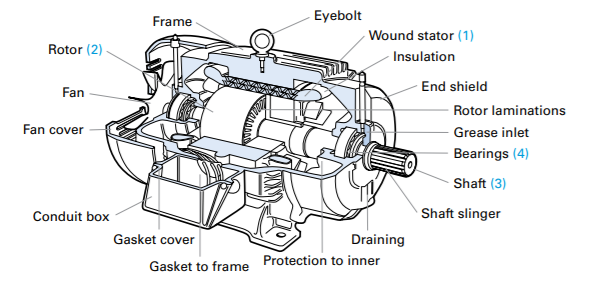An electric motor is a device for converting electrical energy to rotary kinetic (movement) energy in order to power a process such as a pump, fan or conveyor. Motors can be found in the vast majority of equipment, for example:
- The fans that provide combustion air for gas to burn in a heating system.
- The pumps that deliver hot water to a heating system’s radiators.
- The prime mover in an air compressor.
- The device that drives a conveyor belt in a production line.
Electric motive power is likely to form a large part of an organisation’s energy consumption. For every unit of electrical energy (kWh) supplied to a system less than 80% might be converted into useful energy. It is not uncommon to see further energy losses in the system from the equipment being driven (for example a fan being driven by this system might result in a further 25-30% of energy losses). Losses can be minimised and energy savings can be achieved by purchasing and installing energy efficient ETL listed equipment.

Globally, electric motors and electric motor-driven systems are estimated to consume almost 50% of all electricity consumption and account for 70% of electricity consumption in industry.
Line Operated Motors
The line operated AC motors technology covers products that are specifically designed to convert electrical power into mechanical power, and to rotate a drive shaft at a fixed speed that is directly related to the frequency of the electrical power supply.
Line operated AC motors are used to drive plant and machinery throughout industry and commerce, and a wide range of ‘general purpose’ products are available in internationally agreed, standard designs with different rated power outputs, frame sizes, fixed operating speeds, and energy efficiency ratings.
The majority of line operated motors are AC induction motors. However, there are a series of new and more efficient motors entering the market. For example, hybrid permanent magnet motors use built in permanent magnets to reduce rotor losses and increase overall energy efficiency.
Line operated motors eligible under the ETL are single-phase motors and three-phase motors, which have a maximum rated operating voltage of 50V - 1000 V at a frequency of 50Hz. These motors must exceed a minimum efficiency level which depends on the kW rating and the number of poles the motor has.

Example: Replacing a 22kW 4-pole single speed induction motor which has previously been rewound, by an equivalent ETL model operating 24 hours a day, 365 days a year at full load will result in the following potential annual savings:
- £1,400
- 12,600 kWh
- 4.4. tonnes CO2
Variable Speed Drives
A variable speed drive (VSD), is an electronic device that controls the characteristics of a motor’s electrical supply. Therefore, it is able to control the speed and torque of a motor, achieving a better match with the process requirements of the machine it is driving.
There are some applications where varying motor output speeds are preferable, for example fans, pumps, winders and precision tools. Reducing the speed of a pump is more efficient than running the pump at full speed. For example, reducing the fan or pump motor speed by 20% can result in energy savings of up to 50%. A VSD would be used to achieve these energy savings.
VSDs may be purchased either as a stand-alone product or purchased as part of another plant or machinery product. They are included on the ETL because they can realise substantial energy savings when used to control the speed of machinery. The ETL covers two categories of products:
- VSDs for line operated AC motors (as defined within the ETL category line operated AC motors)
- VSDs for converter-fed motors (as defined within the ETL category converter-fed motors)
Converter-Fed Motors
For the ETL, converter-fed AC motor drives consist of a motor, and a matched, electronic variable speed drive that is specifically designed to provide the multi-phase electrical power input needed to operate the motor, and to vary its speed in a controlled manner in response to an external signal.
Converter-fed motors are applied throughout industry and commerce in a wide range of ‘general purpose’ and specialist applications.
The ETL covers three categories of product:
- Converter-fed motors (sold without VSD).
- Integrated converter-fed motor drive units.
- Matched converter-fed motor drive packages.
As converter-fed motors are powered from converters (VSDs) they can realise substantial savings in a wide range of applications, especially when driving variable loads such as fans, pumps, compressors, etc. Converter-fed motors are often smaller and require less cooling. They generally do not require a gearbox, as they have a high turn down which allows operation across a range of speeds and torques. The most common converter-fed motors are permanent magnet synchronous motors (PMSM) and electrically commutated (EC) motors.
PMSM rotors are fitted with permanent magnets which create the rotor magnetic field, rather than aluminium or copper rotor bars (used in induction motors) which incur extra losses.
EC motors are DC motors with an integrated drive allowing direct connection to AC electricity supply. They are more efficient than induction motors as they use permanent magnets rather than copper windings. In addition, the drive also allows more efficient operation at lower speeds, and they are increasingly commonly supplied with fans.
A more recent technology which also falls into this category is synchronous reluctance motors. These are packaged with a drive so can also operate at variable speed, and have an innovative rotor design which reduces losses.